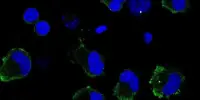A medication can make life safer for children with food allergies by preventing deadly allergic reactions to modest amounts of allergy-triggering foods, according to a new study headed by Stanford School of Medicine researchers.
The findings will be published in The New England Journal of Medicine. The findings show that daily use of the medicine omalizumab may protect people against severe allergic reactions, such as trouble breathing, if they accidently consume a little amount of a food to which they are allergic.
“I’m excited that we have a promising new treatment for multifood allergic patients. This new approach showed really great responses for many of the foods that trigger their allergies,” said the study’s senior author, Sharon Chinthrajah, MD, associate professor of medicine and of pediatrics, and the acting director of the Sean N. Parker Center for Allergy and Asthma Research at Stanford Medicine.
Patients impacted by food allergies face a daily threat of life-threatening reactions due to accidental exposures. The study showed that omalizumab can be a layer of protection against small, accidental exposures.
Robert Wood
“Patients impacted by food allergies face a daily threat of life-threatening reactions due to accidental exposures,” said the study’s lead author, Robert Wood, MD, professor of pediatrics at Johns Hopkins University School of Medicine. “The study showed that omalizumab can be a layer of protection against small, accidental exposures.”
Omalizumab, which was originally licensed by the FDA to treat conditions such as allergic asthma and persistent hives, binds to and inactivates antibodies that cause a variety of allergic diseases. On February 16, the FDA approved omalizumab to reduce the risk of allergic responses to foods based on the findings of a new research.
All trial subjects had severe allergies to peanuts and at least two additional foods. After four months of monthly or biweekly omalizumab injections, two-thirds of the 118 people who received the medicine were able to safely consume tiny amounts of allergy-triggering foods. Notably, 38.4% of the study participants were under the age of six, which is a high risk group for unintentional consumption of allergy-triggering foods.

Allergies are common
Food allergies affect roughly 8% of children and 10% of adults in the United States. People with severe allergies should avoid all meals containing their allergy triggers, but common allergens like peanuts, milk, eggs, and wheat can be hidden in so many locations that attending parties and eating out can be difficult.
“Food allergies have significant social and psychological impacts, including the threat of allergic reactions upon accidental exposures, some of which can be life-threatening,” Chinthrajah told reporters. Families incur economic consequences for purchasing more expensive goods to avoid allergens, she added.
In the best available treatment for food allergies, called oral immunotherapy, patients ingest tiny, gradually increasing doses of allergy-triggering foods under a doctor’s supervision to build tolerance. But oral immunotherapy itself can trigger allergic responses, desensitization to allergens can take months or years, and the process is especially lengthy for people with several food allergies, as they are usually treated for one allergy at a time. Once they are desensitized to an allergen, patients also must continue to eat the food regularly to maintain their tolerance to it — but people often dislike foods they were long required to avoid.
“There is a real need for treatment that goes beyond vigilance and offers choices for our food allergic patients,” Chinthrajah said.
Omalizumab is an injected antibody that binds and deactivates all types of immunoglobin E, or IgE, the allergy-causing molecule in the blood and on the body’s immune cells. So far, omalizumab appears able to provide relief from multiple food allergens at once.
“We think it should have the same impact regardless of what food it is,” Chinthrajah said.
Injections stave off severe reactions
The study included 177 children with at least three food allergies, including 38% aged one to five years, 37% aged six to eleven years, and 24% aged twelve and more. Skin-prick testing and food challenges confirmed participants’ severe food allergies; they reacted to fewer than 100 milligrams of peanut protein and less than 300 milligrams of the other foods.
Two-thirds of the patients were randomly assigned to get omalizumab injections, while one-third received an injected placebo; the injections were administered over 16 weeks. Medication doses were determined based on each participant’s body weight and IgE levels, with injections administered every two to four weeks, depending on the dose required. The participants were re-tested between weeks 16 and 20 to see how much of each allergy-triggering food they could safely tolerate.
Upon re-testing, 79 patients (66.9%) who had taken omalizumab could tolerate at least 600 mg of peanut protein, the amount in two or three peanuts, compared with only four patients (6.8%) who had the placebo. Similar proportions of patients showed improvement in their reactions to the other foods in the study.
About 80% of patients taking omalizumab were able to consume small amounts of at least one allergy-triggering food without inducing an allergenic reaction, 69% of patients could consume small amounts of two allergenic foods and 47% could eat small amounts of all three allergenic foods.
Omalizumab was safe and did not cause side effects, other than some instances of minor reactions at the site of injection. This study marks the first time its safety has been assessed in children as young as 1.
More questions
More research is needed to further understand how omalizumab could help people with food allergies, the researchers said.
“We have a number of unsolved questions, including how long patients should take this medication. Have we permanently altered the immune system? What criteria predict who will respond most strongly?” Chinthrajah spoke. “We don’t know yet.”
The team is preparing studies to answer these and other concerns, such as determining the type of monitoring required to establish when a patient develops substantial tolerance to an allergy-triggering food.
According to Chinthrajah, many patients with food allergies also have additional allergic disorders that can be treated with omalizumab, such as asthma, allergic rhinitis (hay fever and allergies to environmental triggers including mold, dogs/cats), or eczema. “One drug that could improve all of their allergic conditions is exactly what we’re hoping for,” she told me.
The medicine could be especially beneficial for young children with severe food allergies, she suggested, because they tend to put items in their mouths and may be unaware of the risks such allergies bring.
The medicine may also make it safer for community physicians to treat food allergy patients because it does not cause dangerous allergic reactions, as oral immunotherapy occasionally does. “This is something that our food allergy community has been waiting a long time for,” she said. “It’s an easy drug regimen to implement in a medical practice, and many allergists are already using this for other allergic conditions.”
















